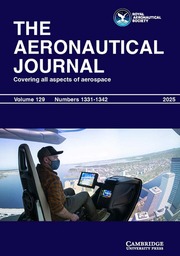No CrossRef data available.
Article contents
Aerodynamic behaviour of ice-debris inside dorsal S-shaped inlet based on overset mesh technology
Published online by Cambridge University Press: 08 April 2025
Abstract
In response to the requirements for assessing the impact safety of aero-engines, a high-fidelity numerical simulation method based on overset mesh technology for six-degree-of-freedom rigid body motion is proposed. A gas-solid two-phase flow model is established, coupling two types of ice-debris (externally ingested ice and internally delaminated ice) with air, to analyse their behaviour in a dorsal S-shaped inlet with a diffusion ratio of 1.3. Results indicate that the ice-debris entering from the upper region of the entrance section exerts the most significant distortion on the total-pressure at the engine inlet. Additionally, the behaviour of ice-debris is determined by its angle with respect to the incoming flow direction and the shape of ice. Furthermore, although the ice-debris detached from the entrance section poses no immediate threat to the engine, the prolonged acceleration by high-speed airflow, with velocity increments exceeding 45 m/s, results in a higher kinetic energy carried upon impact with the inlet walls. Regarding externally ingested ice-debris, a smaller initial velocity corresponds to a higher probability of impacting the engine, accompanied by a significant increase in velocity. For instance, the irregular ice-debris ingested at an initial velocity of 6 m/s can experience velocity amplification exceeding 590%.
Keywords
Information
- Type
- Research Article
- Information
- Copyright
- © The Author(s), 2025. Published by Cambridge University Press on behalf of Royal Aeronautical Society


